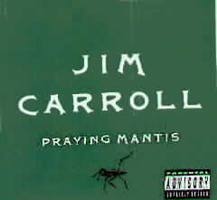
Jim Carroll
Praying Mantis (Giant)
by Marc Hirsh

Jim Carroll
Praying Mantis (Giant)
by Marc Hirsh
originally published in the Rice Thresher, November 15, 1991
Spoken-word albums always pose a problem to me. As much as I might enjoy them the first one or two times, they quickly lose their thrill in a manner that music never does. A musical album can keep me entertained for years as I listen for each different instrument and its effects on the song, the way in which the words complement the music, and vice-versa. With a comedy album, there is only one instrument, and you can pick up on all of the little details the first or second time around.
An album of poetry poses a different problem: why should someone shell out anywhere from ten to fifteen dollars for an audio version of a book when it is generally accepted that the printed word carries more weight than the spoken? Having quickly deduced from the contents of the CD booklet that Praying Mantis by Jim Carroll was in fact poetry and not the efforts of a new, perhaps struggling, songwriter, I was hesitant to listen to it. How could I possibly dare to analyze poetry when it lies outside the realm of my expertise? Sure, I know what I like, but am I really prepared to make judgements that should be made by an English professor?
The answer is no, and I'm not going to make any. What I am going to do is suggest a listen to this collection of performances, not just poetry, by an artist that others may know better than I do. This was my introduction to Carroll, and I intend to follow it up by searching for his written, or, better yet, other recorded works.
"I sleep on a tall roof, scream my songs into lazy floods of stars, and the sounds return, pure and easy. Ah, the city is on my side." This is "Fragment: Little N. Y. Ode," and it sounds a lot better than it looks. Carroll doesn't just read; he explains, using his voice as an instrument to convey meanings that the words would miss on their own. From listening to the album, I get the impression that his body speaks along with his words and his voice, that I'm only getting part of the performance. Still, the voice does a formidable job on its own, and the listener is taken into the album.
There are two types of pieces spotlighted here, poetry and monologues. Of these, the monologues are much more accessible, if only because they're not poetry. Of course, that's the point, but the're still poetic. A prime example is "Times Square's Cage," which traces the narrator's infatuation with a New York prostitute. Realizing that poetry does not require a meter or even rhymes, it is still difficult to think of this piece as a poem. Instead, it's a flood of images which have been put together carefully to give a powerful picture not only of the object but also the nature of the narrator's desire. A listen to the performance makes one wonder the effectiveness of this piece as a written work. Trying to make it written poetry would be missing the point.
Other monologues, such as "Tiny Tortures" and "Monologue: The Loss of American Innocence," the two longest on the album, make the listener laugh without detracting from the beauty of the pieces. On these two in particular, the performance is the most important part. It feels as if Carroll is leading his listeners through a select few moments in his life or the lives of his characters, we're never sure which. "Tortures" is a look at the New York performance artist scene, creating new notions of art while skewering the pretentiousness of old notions. "Innocence" answers the age-old question, "What were you doing when you heard...," which I cannot finish without spoiling the "joke" behind the monologue. Depending on your open-mindedness, you will either be laughing hysterically or writing a letter to your local record store berating them for carrying this album. The "Parental Advisory" sticker is not just for kicks.
The poetry is very pretty. It flows naturally, even if the speaker sometimes hesitates in an unsettling manner on a frequent basis. Whether this is done on purpose or by accident, the pauses, which are rarely longer than a half of a second, add to the beauty of the poems. "A Child Growing Up with the Sun" charms the ears before the brain can fully understand what Carroll means. "Terrorist Trousers" does the same, filling the listener with images that may or may not be familiar. The album closer, "Praying Mantis," describes the picture on the back of the album in terms that would not have been considered by most people. There must be deeper analyses for the poetry segments of the album, but I can only tell you what I know.
Praying Mantis is true performance art, in the respect that the pieces contained on the album would seem incomplete without the author explaining them himself. It's not pretentious or inaccessible, but it's also not for the faint of heart or the lazy of mind. Many of the pieces require thought; some don't. In any respect, Jim Carroll's album should be heard as an important piece of modern art.